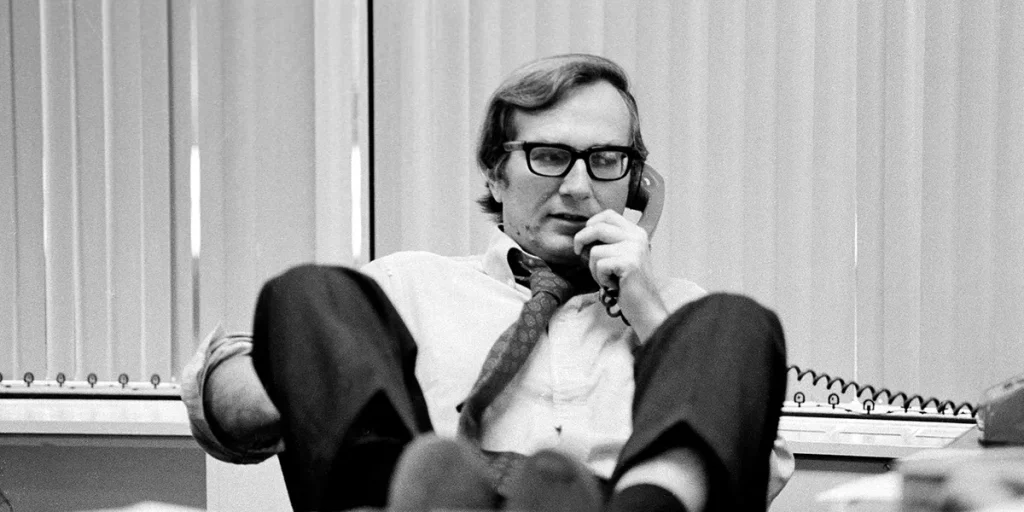With its focus on institutional violence, Cover-Up is an incredibly hard watch, but also a very urgent and needed documentary.
Directors: Laura Poitras and Mark Obenhaus
Genre: Documentary, political thriller
Run Time: 117′
Venice Premiere: August 2025
Theatrical Release: December 19, 2025 (limited, U.S.)
Streaming Release: December 26, 2025 on Netflix
Directed by Laura Poitras and Mark Obenhaus, Cover-Up is an investigative documentary on the life and work of American award-winning journalist Seymour Hersh. The film focuses primarily on interviews from the latter, with video and photographic evidence that support his claims and writing pieces as he explains his research and findings to the audience. Overall, it spans Seymour Hersh’s career as an investigative journalist almost chronologically, from his breakthrough discovery of the lies perpetrated by the government during the Vietnam War to his report on the Nord Stream sabotage in 2023 and with everything else in between.
“This was all supposed to be after death,” says Hersh at the beginning of Cover-Up once he realises that he is not only sharing some key information with the filmmakers but also the identity of his sources. This scene, along with another one towards the end of the documentary when Hersh wants to quit the filming entirely, highlights his fears around making a documentary about himself. As the intertitles tell us, Poitras had first approached him about this in 2005, and the documentary only ever came to life almost 20 years later.
The scenes of doubt and second-guessing highlight Hersh’s reluctance on certain elements being included, mainly in the name of protecting his source’s identities, but also highlight his relationship with the filmmakers. It is clear from these moments that Hersh is in charge of his own story and of what ends up in the film, or doesn’t. While we do hear both Poitras and Obenhaus try and push back at times, his wishes seem to always be respected. The fact that the vulnerable scenes were included in Cover-Up in the first place speaks volumes to this.
Including the subject matter’s own feelings of struggle, both towards the filmmaking process and the very sensitive topics he is covering, is very powerful. They allow the audience to connect with Hersh on a personal level while also holding space for their feelings to witness such heartbreaking and heavy content. The issues that the documentary touches on are dealt with sensitivity while never shying away from telling the audience the truth about what Hersh uncovered, making its impact and context easily understandable for those in the audience who might be unfamiliar with the historical events being discussed. Much like in her previous film Citizenfour, Poitras proves once again how well she can handle complicated topics in Cover-Up.
But Poitras and Obenhaus are also not afraid of calling Hersh out or pointing out his potential mistakes, which adds another layer to Cover-Up. A documentary focused so heavily on one person could have easily become celebratory, but instead, the filmmakers give us an accurate and unfiltered portrayal of the entirety of Hersh’s life and work. While the first half of the film may seem to have a strong focus on the United States and scandals that include the US government, the film does manage to break away from this pattern towards the end. This allows them to make a much more shocking argument about how institutional violence often goes unpunished and ignored on a global level.
Due to its subject matter, Cover-Up is anything but an easy watch. Despite how strong some of its real-life images and videos are and how appalling its revelations can be, it is also a very important documentary. It may start by exposing cases of the past – the My Lai massacre during the Vietnam War and the abuse of prisoners in Abu Ghraib during the Iraq War as two examples of this – but these horrors are far from over. In the last act, Poitras and Obenhaus do an excellent job at tying the whole argument of the film to the present, making it an incredibly urgent watch in today’s geopolitical scenario.
Cover-Up follows a very traditional style of documentary filmmaking that is primarily based on talking heads interviews from Hersh. As he looks at his career retrospectively, in chronological order, the film supplies us with the visual evidence of what he is saying, presented as a mix of archival footage, official documents, and photographs of the time. This structure can easily get repetitive as it always remains the same throughout the documentary, which ultimately hurts its pace.
It is easy to feel paralysed, powerless, and overwhelmed in the face of today’s news, but with its potent and necessary final arc, Cover-Up reminds us that change is possible. It has to be, because like Hersh says, a country cannot get away with this, whether that was the United States during the Vietnam War or a genocide taking place right now before our eyes. Overall, Cover-Up is much more than just another documentary or an analysis of a brilliant man’s career; it is a piece of investigative journalism in and of itself.
Cover-Up: Movie Plot & Recap
Synopsis:
Laura Poitras and Mark Obenhaus explore the life and career of the American investigative journalist Seymour Hersh.
Pros:
- The subject matter is very accessible, even to those who might not be familiar with it beforehand.
- The past events Hersh investigated are brilliantly tied to today’s geopolitical situation.
- It does not shy away from portraying the more difficult moments of Hersh’s life and career.
Cons:
- The documentary employs almost the exact same structure throughout, which can easily feel repetitive.
Cover-Up had its World Premiere at the Venice Film Festival on August 29, 2025. The film will have a one-week, exclusive NYC theatrical release at Film Forum from December 19, 2025, and will be available to stream on Netflix from December 26.

